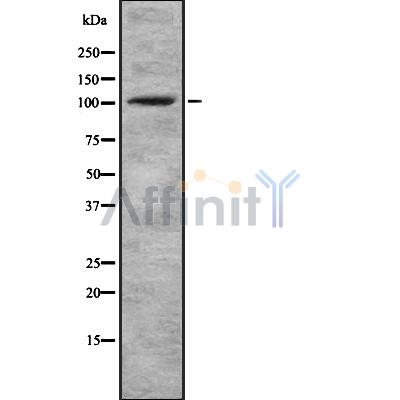ACTN1/2/3/4 Antibody - #DF8633
| Product: | ACTN1/2/3/4 Antibody |
| Catalog: | DF8633 |
| Description: | Rabbit polyclonal antibody to ACTN1/2/3/4 |
| Application: | WB IF/ICC |
| Reactivity: | Human, Mouse, Rat |
| Prediction: | Zebrafish, Bovine, Horse, Sheep, Rabbit, Dog, Chicken, Xenopus |
| Mol.Wt.: | 104 kDa; 103kD,104kD,105kD(Calculated). |
| Uniprot: | P12814 | P35609 | Q08043 | O43707 |
| RRID: | AB_2841837 |
Product Info
*The optimal dilutions should be determined by the end user. For optimal experimental results, antibody reuse is not recommended.
*Tips:
WB: For western blot detection of denatured protein samples. IHC: For immunohistochemical detection of paraffin sections (IHC-p) or frozen sections (IHC-f) of tissue samples. IF/ICC: For immunofluorescence detection of cell samples. ELISA(peptide): For ELISA detection of antigenic peptide.
Cite Format: Affinity Biosciences Cat# DF8633, RRID:AB_2841837.
Fold/Unfold
actinin 1 smooth muscle; Actinin alpha 1; actinin, alpha 1; ACTN 1; Actn1; ACTN1_HUMAN; Alpha Actinin 1; Alpha actinin cytoskeletal isoform; Alpha-actinin cytoskeletal isoform; Alpha-actinin-1; BDPLT15; F actin cross linking protein; F-actin cross-linking protein; FLJ40884; FLJ54432; Non muscle alpha actinin 1; Non-muscle alpha-actinin-1; Actin binding protein; Actinin alpha 2; ACTN 2; ACTN2; ACTN2_HUMAN; Alpha actinin 2; Alpha actinin skeletal muscle; Alpha actinin skeletal muscle isoform 2; Alpha-actinin skeletal muscle isoform 2; Alpha-actinin-2; CMD1AA; F actin cross linking protein; F-actin cross-linking protein; Actinin alpha 3; actinin, alpha; ACTN 3; ACTN3; ACTN3_HUMAN; Alpha actinin skeletal muscle; Alpha actinin skeletal muscle isoform 3; Alpha-Actinin 3; Alpha-actinin skeletal muscle isoform 3; Alpha-actinin-3; F actin cross linking protein; F-actin cross-linking protein; MGC117002; MGC117005; OTTHUMP00000219049; OTTHUMP00000219054; actinin 4; Actinin alpha 4; actinin4; ACTN 4; ACTN4; ACTN4_HUMAN; Alpha-actinin-4; DKFZp686K23158; F actin cross linking protein; F-actin cross-linking protein; Focal segmental glomerulosclerosis 1; FSGS 1; FSGS; FSGS1; Non muscle alpha actinin 4; Non-muscle alpha-actinin 4;
Immunogens
A synthesized peptide derived from human ACTN1/2/3/4, corresponding to a region within the internal amino acids.
P12814(ACTN1_HUMAN) >>Visit HPA database.
P35609(ACTN2_HUMAN) >>Visit HPA database.
Expressed in both skeletal and cardiac muscle.
Q08043 ACTN3_HUMAN:Expressed only in a subset of type 2 skeletal muscle fibers.
O43707 ACTN4_HUMAN:Widely expressed.
- P12814 ACTN1_HUMAN:
- Protein BLAST With
- NCBI/
- ExPASy/
- Uniprot
MDHYDSQQTNDYMQPEEDWDRDLLLDPAWEKQQRKTFTAWCNSHLRKAGTQIENIEEDFRDGLKLMLLLEVISGERLAKPERGKMRVHKISNVNKALDFIASKGVKLVSIGAEEIVDGNVKMTLGMIWTIILRFAIQDISVEETSAKEGLLLWCQRKTAPYKNVNIQNFHISWKDGLGFCALIHRHRPELIDYGKLRKDDPLTNLNTAFDVAEKYLDIPKMLDAEDIVGTARPDEKAIMTYVSSFYHAFSGAQKAETAANRICKVLAVNQENEQLMEDYEKLASDLLEWIRRTIPWLENRVPENTMHAMQQKLEDFRDYRRLHKPPKVQEKCQLEINFNTLQTKLRLSNRPAFMPSEGRMVSDINNAWGCLEQVEKGYEEWLLNEIRRLERLDHLAEKFRQKASIHEAWTDGKEAMLRQKDYETATLSEIKALLKKHEAFESDLAAHQDRVEQIAAIAQELNELDYYDSPSVNARCQKICDQWDNLGALTQKRREALERTEKLLETIDQLYLEYAKRAAPFNNWMEGAMEDLQDTFIVHTIEEIQGLTTAHEQFKATLPDADKERLAILGIHNEVSKIVQTYHVNMAGTNPYTTITPQEINGKWDHVRQLVPRRDQALTEEHARQQHNERLRKQFGAQANVIGPWIQTKMEEIGRISIEMHGTLEDQLSHLRQYEKSIVNYKPKIDQLEGDHQLIQEALIFDNKHTNYTMEHIRVGWEQLLTTIARTINEVENQILTRDAKGISQEQMNEFRASFNHFDRDHSGTLGPEEFKACLISLGYDIGNDPQGEAEFARIMSIVDPNRLGVVTFQAFIDFMSRETADTDTADQVMASFKILAGDKNYITMDELRRELPPDQAEYCIARMAPYTGPDSVPGALDYMSFSTALYGESDL
- P35609 ACTN2_HUMAN:
- Protein BLAST With
- NCBI/
- ExPASy/
- Uniprot
MNQIEPGVQYNYVYDEDEYMIQEEEWDRDLLLDPAWEKQQRKTFTAWCNSHLRKAGTQIENIEEDFRNGLKLMLLLEVISGERLPKPDRGKMRFHKIANVNKALDYIASKGVKLVSIGAEEIVDGNVKMTLGMIWTIILRFAIQDISVEETSAKEGLLLWCQRKTAPYRNVNIQNFHTSWKDGLGLCALIHRHRPDLIDYSKLNKDDPIGNINLAMEIAEKHLDIPKMLDAEDIVNTPKPDERAIMTYVSCFYHAFAGAEQAETAANRICKVLAVNQENERLMEEYERLASELLEWIRRTIPWLENRTPEKTMQAMQKKLEDFRDYRRKHKPPKVQEKCQLEINFNTLQTKLRISNRPAFMPSEGKMVSDIAGAWQRLEQAEKGYEEWLLNEIRRLERLEHLAEKFRQKASTHETWAYGKEQILLQKDYESASLTEVRALLRKHEAFESDLAAHQDRVEQIAAIAQELNELDYHDAVNVNDRCQKICDQWDRLGTLTQKRREALERMEKLLETIDQLHLEFAKRAAPFNNWMEGAMEDLQDMFIVHSIEEIQSLITAHEQFKATLPEADGERQSIMAIQNEVEKVIQSYNIRISSSNPYSTVTMDELRTKWDKVKQLVPIRDQSLQEELARQHANERLRRQFAAQANAIGPWIQNKMEEIARSSIQITGALEDQMNQLKQYEHNIINYKNNIDKLEGDHQLIQEALVFDNKHTNYTMEHIRVGWELLLTTIARTINEVETQILTRDAKGITQEQMNEFRASFNHFDRRKNGLMDHEDFRACLISMGYDLGEAEFARIMTLVDPNGQGTVTFQSFIDFMTRETADTDTAEQVIASFRILASDKPYILAEELRRELPPDQAQYCIKRMPAYSGPGSVPGALDYAAFSSALYGESDL
- Q08043 ACTN3_HUMAN:
- Protein BLAST With
- NCBI/
- ExPASy/
- Uniprot
MMMVMQPEGLGAGEGRFAGGGGGGEYMEQEEDWDRDLLLDPAWEKQQRKTFTAWCNSHLRKAGTQIENIEEDFRNGLKLMLLLEVISGERLPRPDKGKMRFHKIANVNKALDFIASKGVKLVSIGAEEIVDGNLKMTLGMIWTIILRFAIQDISVEETSAKEGLLLWCQRKTAPYRNVNVQNFHTSWKDGLALCALIHRHRPDLIDYAKLRKDDPIGNLNTAFEVAEKYLDIPKMLDAEDIVNTPKPDEKAIMTYVSCFYHAFAGAEQAETAANRICKVLAVNQENEKLMEEYEKLASELLEWIRRTVPWLENRVGEPSMSAMQRKLEDFRDYRRLHKPPRIQEKCQLEINFNTLQTKLRLSHRPAFMPSEGKLVSDIANAWRGLEQVEKGYEDWLLSEIRRLQRLQHLAEKFRQKASLHEAWTRGKEEMLSQRDYDSALLQEVRALLRRHEAFESDLAAHQDRVEHIAALAQELNELDYHEAASVNSRCQAICDQWDNLGTLTQKRRDALERMEKLLETIDRLQLEFARRAAPFNNWLDGAVEDLQDVWLVHSVEETQSLLTAHDQFKATLPEADRERGAIMGIQGEIQKICQTYGLRPCSTNPYITLSPQDINTKWDMVRKLVPSCDQTLQEELARQQVNERLRRQFAAQANAIGPWIQAKVEEVGRLAAGLAGSLEEQMAGLRQQEQNIINYKTNIDRLEGDHQLLQESLVFDNKHTVYSMEHIRVGWEQLLTSIARTINEVENQVLTRDAKGLSQEQLNEFRASFNHFDRKQNGMMEPDDFRACLISMGYDLGEVEFARIMTMVDPNAAGVVTFQAFIDFMTRETAETDTTEQVVASFKILAGDKNYITPEELRRELPAKQAEYCIRRMVPYKGSGAPAGALDYVAFSSALYGESDL
- O43707 ACTN4_HUMAN:
- Protein BLAST With
- NCBI/
- ExPASy/
- Uniprot
MVDYHAANQSYQYGPSSAGNGAGGGGSMGDYMAQEDDWDRDLLLDPAWEKQQRKTFTAWCNSHLRKAGTQIENIDEDFRDGLKLMLLLEVISGERLPKPERGKMRVHKINNVNKALDFIASKGVKLVSIGAEEIVDGNAKMTLGMIWTIILRFAIQDISVEETSAKEGLLLWCQRKTAPYKNVNVQNFHISWKDGLAFNALIHRHRPELIEYDKLRKDDPVTNLNNAFEVAEKYLDIPKMLDAEDIVNTARPDEKAIMTYVSSFYHAFSGAQKAETAANRICKVLAVNQENEHLMEDYEKLASDLLEWIRRTIPWLEDRVPQKTIQEMQQKLEDFRDYRRVHKPPKVQEKCQLEINFNTLQTKLRLSNRPAFMPSEGKMVSDINNGWQHLEQAEKGYEEWLLNEIRRLERLDHLAEKFRQKASIHEAWTDGKEAMLKHRDYETATLSDIKALIRKHEAFESDLAAHQDRVEQIAAIAQELNELDYYDSHNVNTRCQKICDQWDALGSLTHSRREALEKTEKQLEAIDQLHLEYAKRAAPFNNWMESAMEDLQDMFIVHTIEEIEGLISAHDQFKSTLPDADREREAILAIHKEAQRIAESNHIKLSGSNPYTTVTPQIINSKWEKVQQLVPKRDHALLEEQSKQQSNEHLRRQFASQANVVGPWIQTKMEEIGRISIEMNGTLEDQLSHLKQYERSIVDYKPNLDLLEQQHQLIQEALIFDNKHTNYTMEHIRVGWEQLLTTIARTINEVENQILTRDAKGISQEQMQEFRASFNHFDKDHGGALGPEEFKACLISLGYDVENDRQGEAEFNRIMSLVDPNHSGLVTFQAFIDFMSRETTDTDTADQVIASFKVLAGDKNFITAEELRRELPPDQAEYCIARMAPYQGPDAVPGALDYKSFSTALYGESDL
Predictions
Score>80(red) has high confidence and is suggested to be used for WB detection. *The prediction model is mainly based on the alignment of immunogen sequences, the results are for reference only, not as the basis of quality assurance.
High(score>80) Medium(80>score>50) Low(score<50) No confidence
Research Backgrounds
F-actin cross-linking protein which is thought to anchor actin to a variety of intracellular structures. This is a bundling protein.
Cytoplasm>Cytoskeleton. Cytoplasm>Myofibril>Sarcomere>Z line. Cell membrane. Cell junction. Cell projection>Ruffle.
Note: Colocalizes with MYOZ2 and PPP3CA at the Z-line of heart and skeletal muscle. Colocalizes with PSD in membrane ruffles and central reticular structures.
Belongs to the alpha-actinin family.
F-actin cross-linking protein which is thought to anchor actin to a variety of intracellular structures. This is a bundling protein.
Ubiquitinated by FBXL22, leading to proteasomal degradation.
Cytoplasm>Myofibril>Sarcomere>Z line.
Note: Colocalizes with MYOZ1 and FLNC at the Z-lines of skeletal muscle.
Expressed in both skeletal and cardiac muscle.
Belongs to the alpha-actinin family.
F-actin cross-linking protein which is thought to anchor actin to a variety of intracellular structures. This is a bundling protein.
Expressed only in a subset of type 2 skeletal muscle fibers.
Belongs to the alpha-actinin family.
F-actin cross-linking protein which is thought to anchor actin to a variety of intracellular structures. This is a bundling protein (Probable). Probably involved in vesicular trafficking via its association with the CART complex. The CART complex is necessary for efficient transferrin receptor recycling but not for EGFR degradation. Involved in tight junction assembly in epithelial cells probably through interaction with MICALL2. Links MICALL2 to the actin cytoskeleton and recruits it to the tight junctions (By similarity). May also function as a transcriptional coactivator, stimulating transcription mediated by the nuclear hormone receptors PPARG and RARA.
Nucleus. Cytoplasm. Cell junction. Cytoplasm>Cytoskeleton>Stress fiber.
Note: Localized in cytoplasmic mRNP granules containing untranslated mRNAs. Nuclear translocation can be induced by the PI3 kinase inhibitor wortmannin or by cytochalasin D. Exclusively localized in the nucleus in a limited number of cell lines (breast cancer cell line MCF-7, oral floor cancer IMC-2, and bladder cancer KU-7).
Widely expressed.
Contains one Leu-Xaa-Xaa-Leu-Leu (LXXLL) motif that mediates interaction with nuclear receptors.
Belongs to the alpha-actinin family.
Research Fields
· Cellular Processes > Cellular community - eukaryotes > Focal adhesion. (View pathway)
· Cellular Processes > Cellular community - eukaryotes > Adherens junction. (View pathway)
· Cellular Processes > Cellular community - eukaryotes > Tight junction. (View pathway)
· Cellular Processes > Cell motility > Regulation of actin cytoskeleton. (View pathway)
· Human Diseases > Infectious diseases: Parasitic > Amoebiasis.
· Human Diseases > Cancers: Overview > Viral carcinogenesis.
· Human Diseases > Immune diseases > Systemic lupus erythematosus.
· Human Diseases > Cardiovascular diseases > Arrhythmogenic right ventricular cardiomyopathy (ARVC).
· Organismal Systems > Immune system > Leukocyte transendothelial migration. (View pathway)
Restrictive clause
Affinity Biosciences tests all products strictly. Citations are provided as a resource for additional applications that have not been validated by Affinity Biosciences. Please choose the appropriate format for each application and consult Materials and Methods sections for additional details about the use of any product in these publications.
For Research Use Only.
Not for use in diagnostic or therapeutic procedures. Not for resale. Not for distribution without written consent. Affinity Biosciences will not be held responsible for patent infringement or other violations that may occur with the use of our products. Affinity Biosciences, Affinity Biosciences Logo and all other trademarks are the property of Affinity Biosciences LTD.
